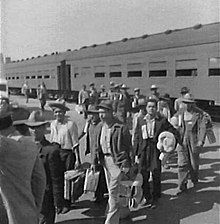
Back Programa Bracero Catalan Bracero-Programm German Programa Bracero Spanish Bracero programm Estonian Bracero French Braceroprogramma Dutch
This article is written like a research paper or scientific journal. (January 2022) |

| This article is part of a series on the |
| History of Chicanos and Mexican Americans |
|---|
The Bracero Program (from the Spanish term bracero [bɾaˈse.ɾo], meaning "manual laborer" or "one who works using his arms") was a U.S. Government-sponsored program that imported Mexican farm and railroad workers into the United States between the years 1942 and 1964.
The program, which was designed to fill agriculture shortages during World War II, offered employment contracts to 5 million braceros in 24 U.S. states. It was the largest foreign worker program in U.S. history.[1]
The program was the result of a series of laws and diplomatic agreements, initiated on August 4, 1942, when the United States signed the Mexican Farm Labor Agreement with Mexico.[2] For these farmworkers, the agreement guaranteed decent living conditions (sanitation, adequate shelter, and food) and a minimum wage of 30 cents an hour, as well as protections from forced military service, and guaranteed that a part of wages was to be put into a private savings account in Mexico. The program also allowed the importation of contract laborers from Guam as a temporary measure during the early phases of World War II.[3]
The agreement was extended with the Migrant Labor Agreement of 1951 (Pub. L. 82–78), enacted as an amendment to the Agricultural Act of 1949 by the United States Congress,[4] which set the official parameters for the Bracero Program until its termination in 1964.[1]
In studies published in 2018 and 2023, it was found that the Bracero Program did not have an adverse effect on the wages or employment for American-born farm workers, [5] and that termination of the program had adverse impact on American-born farmers and resulted in increased farm mechanization.[6]
Since abolition of the Bracero Program, temporary agricultural workers have been admitted with H-2 and H-2A visas.
- ^ a b Calavita, Kitty (1992). Inside the State: The Bracero Program, Immigration, and the I. N. S. New York: Quid Pro, LLC. p. 1. ISBN 0-9827504-8-X.
- ^ "Bracero History Archive | About". braceroarchive.org. Retrieved October 11, 2019.
- ^ Koestler, Fred L. "Bracero Program". tshaonline.org. Retrieved December 2, 2015.
- ^ "SmallerLarger Bracero Program Begins, April 4, 1942". Student Resources in Context. Gale, Cengage Learning. Retrieved March 17, 2017.[permanent dead link]
- ^ Cite error: The named reference
Clemens-2018was invoked but never defined (see the help page). - ^ Cite error: The named reference
:2was invoked but never defined (see the help page).